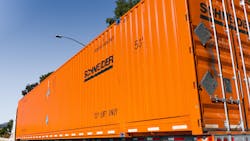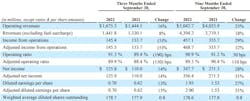Revenues for Schneider National hit record highs in the third quarter, growing 16% year-over-year to $1.675 billion, according to an Oct. 27 earnings call with investors. Executives attributed much of Schneider’s success in Q3 to higher truckload and intermodal revenues.
Schneider, which is No. 11 on the FleetOwner 500: Top For-Hire Fleets of 2022 list, had the best third quarter in its history. Ending Sept. 30, revenue in Q3 2022 beat Q3 2021 inflows of $1.445 billion by $230 million—about 16%.
See also: Knight-Swift eyes acquisitions as market turns
The company’s truckload revenue was $571.2 million for Q3, an increase of $86.8 million, or 18%, year-over-year. In a release, Schneider attributed much of its truckload success to Midwest Logistics Systems, an Ohio-based carrier acquired by Schneider in January. Revenue per truck increased to $4,178 per week, a 3% year-over-year increase.
“In the third quarter, shifting freight fundamentals resulted in a more balanced supply and demand condition,” Mark Rourke, Schneider's president and CEO, said in the release. “In our truckload segment, we experienced softer network volumes, while our dedicated fleet increased 42% over the prior year. Our intermodal segment grew volumes while navigating several supply chain and network challenges, mostly short-term in nature, that compressed margin. Our logistics segment continued to improve volumes and net revenue per order year over year, driven by increasing traction of our power only offering and Schneider FreightPower platform.”
In one of the few less-than-optimistic comments during Schneider's earnings call with investment analysts, Rourke suggested that equipment replacement will remain a challenge.
"One of the difficulties of having the OEM issues that we have, which we fully expect to continue to some degree in all of 2023, is that we have multiple hundreds of units that are beyond what we would consider our ideal life; that is, from an expense standpoint—maintenance, parts—a real drag on the operating income statement."
Schneider's logistics revenue dips, intermodal increases
Logistics revenue, however, decreased 2% compared to the same quarter last year due to lower spot rates, although this was alleviated slightly by brokerage volume growth.“In a moderating spot market environment, our brokerage business grew order volumes year-over-year by 5% and expanded net revenue per order by 10%,” Rourke said during the investors call. “We believe we are in the early stages of capacity level correction, especially with the small carrier community that increasingly relies on the spot market.
"It is our assessment that a meaningful portion of the spot market has dropped below the breakeven point for carriers. There are a series of meaningful and persistent inflationary impacts facing the small carrier community, such as wages, equipment, acquisition costs, replacement parts and fuel to name a few. "
Intermodal revenues increased 13% year-over-year to $334.7 million due to higher revenue per order and volume growth. Schneider CFO and Executive VP Stephen Bruffet said that September saw a shift from intermodal volume to truckload as shippers were concerned about the possibility of a strike among rail workers, fears that eased mid-September but reignited in October as one union rejected the tentative deal. A company press release cited elevated container dwell times and delayed chassis deliveries as additional pressures to intermodal volume growth.
“Our outlook for the remainder of 2022,” Bruffet said, “continues to call for stable market conditions and freight volumes, along with a muted peak season. Freight volumes, especially in the contractual space, are expected to remain steady through mid-December and then experience a typical seasonal decline in the last couple of weeks of the year.”
Bruffet said that although they expect supply chain issues to persist through 2023, he expected inflationary pressure to be “at a much lower rate than what’s been experienced over the last 18 months or so.”
Adjusted diluted earnings per share for Q3 2022 were $0.70 compared to $0.62 in the third quarter last year.
Rourke stated in the release that, “Coming into the quarter, we actively positioned our portfolio for the changing market conditions and continue to see supportive contractual volumes and pricing across our enterprise.” He concluded: “We look forward to closing out the year well-positioned for 2023 and our strategic pursuit of higher returns on capital and earnings resiliency through continued growth in our dedicated, intermodal, and logistics operations.”
All revenue figures exclude fuel surcharges.
About the Author
Scott Keith
Scott Keith is a former fleet owner digital editor, who was on staff from 2022 to 2023.


